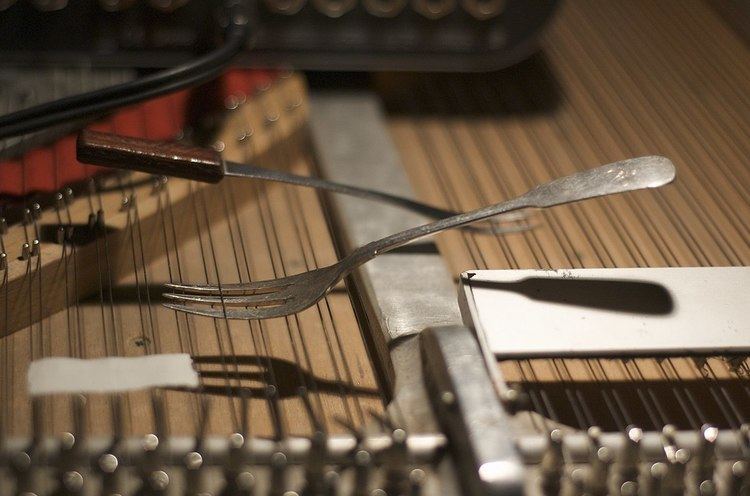 | ||
A prepared piano is a piano that has had its sound altered by placing objects (called preparations) on or between the strings.
Contents
Technique
Although theoretically any object could be used to prepare a piano, in practical application preparation objects are usually expected to have certain characteristics:
Additionally, most preparations will change the timbre of the string in such a way that the original pitch of the string will no longer be perceptible, though there are occasional exceptions to this.
Delage
In his Ragamalika (1912–22), based on the classical music of India, French composer Maurice Delage (1879–1961) calls for a piece of cardboard to be placed under the B-flat in the second line of the bass clef to dampen the sound, imitating the sound of an Indian drum.
Cowell
In 1922 American Composer Henry Cowell (1897–1965) pioneered a technique he dubbed "string piano", which involved having the pianist reach inside the piano and pluck, sweep, scrape, thump, and otherwise manipulate the strings directly, rather than using the keyboard. He developed these techniques in pieces such as Aeolian Harp (1923) and The Banshee (1925). Although Cowell's techniques don't call for placing objects (other than the hands) inside the piano, Cage frequently cited Cowell's work as the primary inspiration for his development of the prepared piano.
Villa-Lobos
In his Chôros No. 8, a 1925 work for two pianos and large orchestra, Heitor Villa-Lobos added to his score instructions to the pianist to insert pieces of paper between the strings and the hammers to attain a certain sonority.
John Cage
The invention of the "prepared piano", per se, is usually traced to John Cage. Cage first prepared a piano when he was commissioned to write music for "Bacchanale", a dance by Syvilla Fort in 1938. For some time previously, Cage had been writing exclusively for a percussion ensemble, but the hall where Fort’s dance was to be staged had no room for a percussion group. The only instrument available was a single grand piano. After some consideration, Cage said that he realized it was possible “to place in the hands of a single pianist the equivalent of an entire percussion orchestra ... With just one musician, you can really do an unlimited number of things on the inside of the piano if you have at your disposal an exploded keyboard”.
Other composers, arrangers, performers, and compositions
Tack piano
Strictly speaking, a tack piano is not a prepared piano, since
Although the tacks can be removed from the hammers, inserting them causes permanent damage to the felt, and for this and other reasons the use of tacks is generally discouraged by piano technicians.
Acoustisizer
The Acoustisizer is an electroacoustic musical instrument built from a small grand piano with built in speakers, magnetic guitar pickups, PZMs, and prepared piano strings. It was built as part of a graduate thesis project at California State University Dominguez Hills by Bob Fenger (1983), a student of Richard Bunger (author of the Well Prepared Piano). Speakers are built into the bottom of the instrument, redirecting its own amplified sound back onto the sounding board, with strings and magnetic pickups creating an amplitude intensity loop which in turn drives and vibrates suspended kinetic oscillators (assemblages of vibration sensitive materials). Secondary control parameters allow extraction of vibration and sound phenomena from the kinetic oscillators through a series of proximity microphones and PZMs (piezo electric contact mics). An article was written by the inventor and was published in Experimental Musical Instruments Magazine April 1991, Nicasio CA. It includes pictures of the kinetic oscillators and stages of the construction process including an underbody view of the speaker system configuration.
